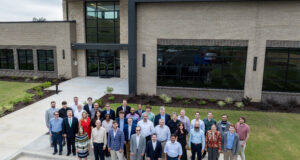FTCN Replay: Looking Ahead to AOC 2025 and the Next Decade of EMSO
What to expect at AOC 2025 as EW community tackles spectrum dominance, technology, and training challenges through 2035
The Association of Old Crows is preparing for a critical conversation about the future of electromagnetic warfare at its upcoming AOC 2025, December 9-11 in National Harbor, MD. In a special episode of From the Crows’ Nest, host and AOC Director of Advocacy & Outreach Ken Miller sat down with retired US Army Colonel Kevin Finch, who serves on the AOC Board and played a key role in developing this year’s symposium program. They discussed why the event’s theme – Charting a Path to 2035: Navigating the Future of Electromagnetic Spectrum Operations – represents such a pivotal moment for the defense community.
The year 2035 isn’t arbitrary. As Finch explained, Congress passed legislation setting Department of Defense top-line budget numbers through 2035, providing a concrete planning horizon.
“We know what the basic numbers are,” Finch said. “And from that, you know, we can kind of interpolate what’s the amount of money the DOD is looking to spend over that period of time? And then from that, that’s when all the planning starts.”
This financial framework allows the requirements community to begin asking critical questions about future threats and necessary equipment. However, electromagnetic spectrum operations typically receive only a small slice of the overall defense budget, despite their fundamental importance to modern warfare.
Recent conflicts have dramatically illustrated the centrality of spectrum control. Both the war in Ukraine and operations in the Middle East have demonstrated that dominance in the electromagnetic spectrum plays a significant role in how militaries conduct warfare. At the recent Association of the United States Army (AUSA) conference, the Secretary of the Army identified electromagnetic warfare as one of his top priorities, reflecting a growing recognition across the services.
“The control of the spectrum is one of the key tasks you have to do in modern warfare,” Finch emphasized. “And right now, if you look in Ukraine, for instance, that’s very true every day.”
The Army has been shifting its approach to electronic warfare in notable ways. Rather than focusing solely on large, capital-intensive systems costing millions of dollars, the service is now looking at lower-cost, low size-weight-and-power attritable systems that perform specific functions. This change stems from a harsh lesson learned in Ukraine: If something is emitting, it becomes a target, and if it’s a target, it will likely be destroyed.
The Army is also pushing capability closer to the soldier level, moving away from its previous focus on brigade-level and above systems. High-altitude balloon capabilities and various sensing platforms are being explored to provide different vantage points for sensing the battlefield and conducting deception operations.
Adaptability remains paramount in an uncertain global security environment. Finch stressed that program managers aren’t building systems for today – they’re building for 20 years from now.
“We have to have the systems designed to be upgraded from the beginning,” he said. This requires embracing modular open systems architectures and enabling rapid reprogramming capabilities that allow soldiers to update code and threat libraries in near-real time.
Two philosophical approaches are emerging: designing systems that can be upgraded to address emerging threats continuously or adopting a Silicon Valley approach where new capabilities keep rolling out the door on a rapid basis, designed for specific threats of the moment. Both approaches require maintaining a warm industrial base and keeping engineers engaged.
The relationship between government and industry must evolve to support these goals. Finch emphasized that government must telegraph its demand signals.
“That is what’s going to get industry, not only [to ask]what do you want, but how many are you looking to buy?” he said. Return on investment considerations drive industry decisions, making ongoing dialogue essential.
“My advice to the acquisition community is about the time you’re sick of saying it is about when people are getting it,” Finch offered, underscoring the need for consistent communication.
The AOC 2025 summit will bring together speakers from across the government ecosystem – the White House, Congress, military services, and combatant commands – to address these challenges. The event will feature keynotes from Laurie Moe Buckhout, former Assistant National Cyber Director for Policy at the White House; The Honorable Don Bacon, a retired brigadier general and current member of the House of Representatives whom Finch described as “probably the foremost expert of electronic warfare in Congress;” and Lieutenant General Paul T. Stanton, Commander of the Department of War Cyber Defense Command and Director of the Defense Information Systems Agency.
“We have some really awesome keynotes that are hitting the major silos of government,” Finch said. “So we have the White House one day, we have the Congress the next, and then we have the operational force the final day. And I think it’s a really great lineup setting up what we really looking to do in our spotlight panels and our breakout sessions.”
Training and recruitment also present ongoing challenges as systems are upgraded more frequently and units aren’t uniformly equipped. “Nobody’s pure fleeted per se,” Finch explained, meaning what one unit has may differ from another. This reality demands more robust training that continues throughout a service member’s career, not just at the beginning.
AOC 2025 aims to tackle these complex issues through spotlight panels and breakout sessions. With the global security environment remaining volatile and adversaries advancing their own capabilities, the conversations in December could help shape how the United States maintains its advantage in the electromagnetic spectrum for the next decade.
_____________________
Register for AOC 2025 Before Prices Increase November 15!
Join nearly 2,500 experts from more than 40 countries who will gather to explore and examine the future of electromagnetic warfare and spectrum operations amidst significant political, strategic, economic, and technological changes.
This year’s program delivers what you need to stay ahead: technical deep dives into emerging threats, strategic sessions on spectrum dominance, and direct access to the leaders shaping policy and operations through 2035.
From defense policy to congressional oversight and military command perspectives, you’ll gain insights that translate directly to your mission. Don’t miss the conversations, connections, and capabilities that will define your future.





